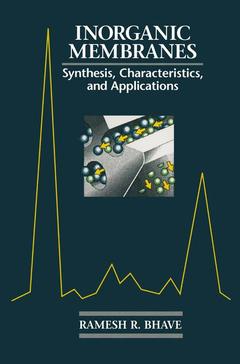Inorganic Membranes Synthesis, Characteristics and Applications, 1991 Synthesis, characteristics, and applications
Langue : Anglais
Auteur : Bhave R.

Here is the first book devoted completely to inorganic membrane separations and applications. It provides detailed information on all aspects of the development and utilization of both commercial and developmental inorganic membranes and membrane-based processes, pointing out their key advantages and limitations as separation tools. Characteristics, technological advances, and future applications of inorganic membranes are discussed in depth. An overview of the origins of these membranes provides a basis for understanding emerging technologies in the field. Coverage of thermal, chemical, surface, and mechanical properties of inorganic membranes includes discussion of pore diameter, thickness, and membrane morphology. You'll gain valuable insights into membrane modification, as well as the design and operation of membrane filtration units. Also included are sections on how to analyze mechanisms that affect flux feature models for prediction of micro- and ultrafiltration flux that help you minimize flux decline. Descriptions of cross-flow membrane filtration and common operating configurations clarify the influence of important operating parameters on system performance. Parameters influencing solute retention properties during ultrafiltration are identified and discussed or treated in detail.
1. The Developing Use of Inorganic Membranes: A Historical Perspective.- 1.1. Introduction.- 1.2. The Nuclear Period.- 1.3. The Development of Ultrafiltration and Microfiltration Inorganic Membranes: The 1980-1990 Period.- 1.4. The Third Stage in the Development of Inorganic Membranes: Further Developments by Other Organizations.- 1.5. Conclusions.- References.- 2. Synthesis of Inorganic Membranes.- 2.1. Introduction and Overview.- 2.2. Basic Principles of Membrane Synthesis.- 2.3. Packing of Particles from Suspensions.- 2.4. Typical Results for Different Materials.- 2.5. Phase Separation Leaching Methods and Glass Membranes.- 2.6. Anodic Oxidation.- 2.7. Pyrolysis.- 2.8. Track-Etch Method.- 2.9. Composite Membranes: Modification Methods.- 2.10. Miscellaneous Methods and Comments.- References.- 3. General Characteristics of Inorganic Membranes.- 3.1. Introduction.- 3.2. Commercial Inorganic Membranes.- 3.3. Microstructural Characteristics.- 3.4. Materials Properties.- 3.5. Membrane Element and Module Configurations.- 3.6. End-seal and Module Packing Materials.- References.- 4. Permeation and Separation Characteristics of Inorganic Membranes in Liquid Phase Applications.- 4.1. Introduction.- 4.2. Common Terminology and Definitions.- 4.3. Phenomena Influencing Flux and Separation During the Filtration Process.- 4.4. Microfiltration.- 4.5. Ultrafiltration.- 4.6. Liquid Permeation and Separation with Formed-in-Place (Dynamic) Membranes.- 4.7. Dense Membranes.- Nomenclature.- References.- 5. Liquid Filtration and Separation with Inorganic Membranes: Operating Considerations and some Aspects of System Design.- 5.1. Introduction.- 5.2. Cross-flow Membrane Filtration.- 5.3. The Effect of Operating Parameters on Membrane Filtration and Separation Performance.- 5.4. Backflushing:Theoretical Aspects.- 5.5. Membrane Regeneration.- 5.6. Microfiltration with Uniform Transmembrane Pressure.- 5.7. Operating Configurations.- 5.8. Some Aspects of System Design and Operation.- Nomenclature.- References.- 6. Gas Separations with Inorganic Membranes.- 6.1. Introduction.- 6.2. Porous Membranes.- 6.3. Dense Membranes.- 6.4. New Developments.- 6.5. Conclusions.- Nomenclature.- References.- 7. Inorganic Membrane Reactors to Enhance the Productivity of Chemical Processes.- 7.1. Inorganic Membranes for High-Temperature Applications.- 7.2. Gas (or Vapor) Phase Reactions: The Concept of the Membrane Reactor.- 7.3. Fundamental Aspects of Membrane Reactors.- 7.4. Assessment of Commercial Possibilities.- References.- 8. Inorganic Membranes in Food and Biotechnology Applications.- 8.1. Introduction.- 8.2. Applications of Inorganic Membranes in the Dairy Industry.- 8.3. Inorganic Membranes in the Clarification of Fruit Juices.- 8.4. Applications of Inorganic Membranes to Concentrate Proteinsin Food Industry.- 8.5. Clarification of Fermented Alcoholic BeveragesUsing Inorganic Membranes.- 8.6. Inorganic Membranes in Biotechnology Applications.- References.- 9. Inorganic Membranes for the Filtration of Water, Wastewater Treatment and Process Industry Filtration Applications.- 9.1. Introduction.- 9.2. Filtration of Water Using Inorganic Membranes.- 9.3. Non-oily Wastewater Treatment With Inorganic Membranes.- 9.4. Oily Wastewater Treatment with Inorganic Membranes.- 9.5. Inorganic Membranes in Process Industry Filtrations.- References.
Date de parution : 02-2012
Ouvrage de 336 p.
15.2x22.9 cm
Thèmes d’Inorganic Membranes Synthesis, Characteristics and... :
Mots-clés :
biotechnology; filtration; food; ultrafiltration; wastewater
© 2024 LAVOISIER S.A.S.
